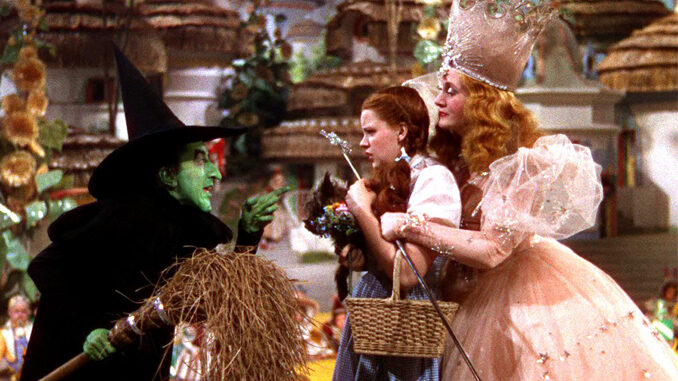
by Sean William Menzies
Fantasy has had a rather schizophrenic time in Hollywood––one year being the worst possible genre to pour money into unless it’s going straight to video, the next year sweeping the Academy Awards with 11 Oscars. But one thing is certain: It will always find an audience.
This year marks the 70th anniversary of one of the greatest fantasy films, if not the greatest, ever made: MGM’s The Wizard of Oz. Based on L. Frank Baum’s The Wonderful Wizard of Oz (1901), this musical film adaptation hardly needs any introduction––unless of course you’ve just landed here from some distant galaxy far beyond any reception of CBS’ perennial springtime broadcasts of the classic. With ruddy sepia tone, blazing Technicolor, outstanding music and songs, and a cast as legendary as the Roman names for the constellations, the film has somehow worked its way into American culture and affixed itself firmly as a cornerstone in the unbelievably odd temple of Hollywood.
There are reasons for this, I believe, other than that it is one of those perfect creations that emerged from the Dream Factory just before World War II altered our view of the world and ourselves. Baum wrote the single most important American mythology with his little book, and he knew it. The novel is a deliberate reflection of America at the turn of the 20th century––socially, economically and politically––and the interesting and possibly disturbing thing is, it’s still relevant.
Dorothy, of course, represents the children (the future). Her sense of Home has been violently displaced by a natural disaster, or the winds of change, and she just wants to get back to the security she once knew. Along the way she meets a Scarecrow (the so-called brainless farmer), a Tin Man (the heartless Industrial Revolution) and a Cowardly Lion (the pusillanimous judicial system–– although it could also mean the craven educational system, since stone lions are usually out- side of libraries––that was at the time too afraid to move towards advanced thinking rather than lag 1,300 years behind; only Baum knows for certain and he ain’t telling!).
Dorothy leads her new friends to the Emerald City, the center of government, for help. The city being green, like money, should be self-explanatory. Upon arrival, they are turned away and told it would take an Act of Congress to see the Wizard (we all know who that’s supposed to be). An act of compassion from a sensitive guard gets these four friends in to see the All-Powerful Oz (see, even then it was all about who you know). But they soon dis- cover that, rather than the amazing head of state he has been made out to be, he is merely a quivering entrepreneur from Omaha. Nice guy, but ultimately useless.
In the end, the Scarecrow, Tin Man and Cowardly Lion all learn that what they sought was what they actually possessed all along: Brains, Heart and Courage, respectively. And even Dorothy realizes that Home is where you make it. In the book, it is her Silver Shoes (hard cash) that buy her a ticket back to Kansas. In the film, Dorothy’s shoes have been changed to Ruby Slippers, while her gingham dress is blue and white; she is literally wearing the colors of the American flag.
And what of the Wicked Witch of the West? Perhaps that unhappy creature represents the failure of parenthood or something. The poppies she conjures to drug Dorothy and her friends are clearly a reference to the opium problem at the time. Yes, she’s a pusher and in the book enslaves children to clean her castle (itself an ancient device in mythology going back to Hansel und Gretel, and beyond).
The Wizard of Oz proves that motion pictures are indeed the New Mythology and have been for a hundred years or so. Films do everything that prehistoric cave paintings did, only they move and have 5.1 Surround Sound. The audience members sit in their pews, all looking in the same direction, waiting for the wall before them to open up and to please, please tell them something about the human condition, something that will make them for- get, but remember; laugh, but cry; dream but not have nightmares; and feel as if we’ve always been here and always will.
Oz speaks across generations and, because the filmmakers understood and were respectful of their source, its meaning still resonates today, despite how much our world has changed in the past 70 years.
Then again, maybe it’s just the bright colors and catchy tunes.





